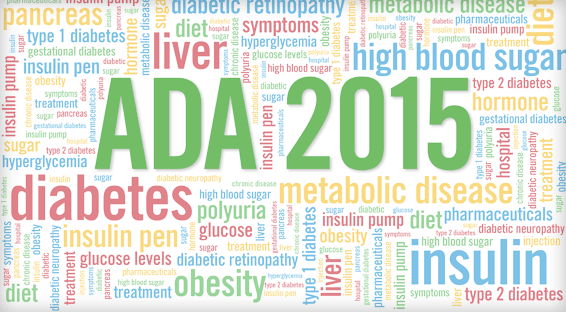New research was presented at ADA 2015, the annual scientific sessions of the American Diabetes Association, from June 5 to 9 in Boston. The features below highlight some of the studies that emerged from the conference.
Telemonitoring for Metabolic & Cardiovascular Risk in Diabetics
The Particulars: Telemedicine systems combine home monitoring with remote educational interventions and may be a desirable strategy for treating patients with diabetes. Little is known regarding the use of these systems in addressing metabolic control and overall cardiovascular risk in patients.
Data Breakdown: Study investigators randomized patients with type 2 diabetes to usual care or a home telehealth system intervention that enabled patients to monitor body weight, blood glucose, and blood pressure. The telehealth system also offered remote educational support and feedback to the physician. Patients in the home telehealth group achieved statistically significant reductions in A1C levels at 12 months when compared with the usual care group. The home telehealth group also had better quality-of-life scores and reported few specialist visits.
Take Home Pearl: When compared with usual care, use of a home telehealth system among patients with type 2 diabetes appears to improve metabolic control and quality of life and reduces resource utilization.
Comparing Insulin Delivery Approaches
The Particulars: Prior studies comparing continuous subcutaneous insulin infusion (CSII) with multiple daily injections (MDI) in patients with type 2 diabetes have provided inconclusive findings.
Data Breakdown: Patients with poor glycemic control who were taking multiple doses of insulin were randomized to CSII or MDI for a study. Patients in the CSII group achieved significantly greater reductions in A1C when compared with those in the MDI group. An A1C of less than 8% was achieved by 57% of patients in the CSII group and 27% in the MDI group. After 12 months, the CSII group had a 20% lower total daily insulin dose than the MDI group. Neither group experienced ketoacidosis. Severe hypoglycemia occurred in only one patient, who was in the MDI group.
Take Home Pearls: In patients with poorly controlled type 2 diabetes, CSII appears to provide significant improvements in glycemic control when compared with MDI. CSII also appears to allow for lower insulin does requirements without impacting safety or increasing the risk of hypoglycemia.
Online Game Teaches Insulin Prescribing
The Particulars: Previous research suggests that providers of patients with type 2 diabetes often lack expertise in insulin therapy. An online game may provide a more interactive and realistic approach to continuing medical education for these providers than traditional lectures.
Data Breakdown: For a study, researchers randomized physicians to receive education about insulin therapy through traditional instruction or from an online game in which the player must assess patients with diabetes and decide what should be done to improve glycemic control. The average rate of correct answers on an insulin knowledge questionnaire improved from 52% at baseline to 85% after traditional education and to 92% after game-based education. The average improvement in score was higher in the game group, and 96% of all participants thought the game was fun.
Take Home Pearl: An online game designed to provide insulin therapy education appears to be fun and slightly more effective than traditional education.
Vitamin D & Diabetic Neuropathy
The Particulars: Vitamin D and neuropathy have been found to be related in previous studies. However, seasonal differences in vitamin D and activity variations that affect vitamin D exposure have not been accounted for in these studies.
Data Breakdown: Researchers conducting a study measured vitamin D levels over several months among patients with type 2 diabetes and painful neuropathy, painless neuropathy, or no neuropathy and compared them with healthy volunteers. After adjustment for age, BMI, and sunlight exposure, the following was observed:
Characteristics Vitamin D Levels
Patients with painful neuropathy 34.34 nmol/L
Patients with painless neuropathy 53.22 nmol/L
Patients with no neuropathy 50.00 nmol/L
Healthy volunteer 64.95 nmol/L
Take Home Pearl: Painful diabetic neuropathy appears to be associated with significantly reduced vitamin D levels, independent of sunlight exposure, age, or BMI.
Assessing an Innovative Diabetes Education Tool
The Particulars: Research suggests that patient education improves self-management and metabolic control in patients with diabetes, but many of these individuals do not receive such education.
Data Breakdown: For a study, patients with type 2 diabetes were randomized to patient education with the Conversation Maps (CM) educational tool combined with a weight loss regimen (group A) or to an education program with CM (group B). After 3 months, group A and B maintained body weight (BW) and waist circumference (WC). However, group B significantly reduced both BW and WC after 4 weeks. The combined intervention (group A) also had better knowledge about therapy and prevention and treatment of diabetic foot.
Take Home Pearls: Pairing CM with a weight loss program appears to be an effective educational tool to help patients manage their diabetes.


